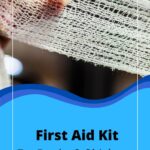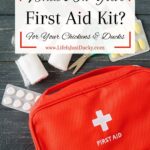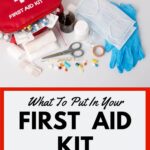Keeping a first aid kit for chickens and ducks is a good idea. As many injuries are easily taken care of right at home with just a few supplies.
We spend hours planning the arrival of our first birds. What breeds we want and how we will house them, but we generally give very little thought to what we will do if one of our birds gets hurt or sick.
Don’t wait until an emergency happens. It’s a good idea to plan ahead so you have the supplies you need on hand if, or more likely when, that day comes.
This post may contain affiliate links. I will be compensated if you make a purchase after clicking on my links. Please read my disclosure if you have questions.
Thank you for supporting this site with purchases made through links in this post. For Starters Here’s My Amazon Link.
Disclaimer: I am not a veterinarian. Any advice on caring for animals or diagnosing & treating medical conditions for animals is for informational purposes and should be evaluated by a trained veterinarian.
Table of Contents
First Aid Kit For Chickens And Ducks.
Every chicken and duck owner should stock a first aid kit. Many injuries and illnesses can be easily treated at home with a few simple supplies. It’s a good idea to be prepared by stocking a few essentials.
Also, vet bills can be very expensive, and most vets are not experts in treating chickens and ducks. Treating them quickly, yourself, saves both lives and money. Being prepared with supplies and information can make a difficult situation less stressful.
Duck And Chicken First Aid.
Just as you would treat a cold or a skinned knee on your child with the supplies you have in your medicine cabinet, your ducks and chickens can be treated for minor ailments also.
The below supplies are a great place to start your flock’s first aid kit. It is not an exhaustive list. Once you have kept birds for a while, you will probably want to add additional items to your kit. But this is a great place to start so you will have the basics on hand for the things that you may need.
Prevention Is Worth A Pound Of Cure.
Chickens are relatively easy to keep, and ducks are even easier, so long as you provide quality feed, fresh water, and a secure coop that is clean, dry, and well-ventilated. But there are a few other things you can do that will help them stay healthy too.
Related>> A Well Designed Duck Coop To Make Your Life Easier.
Natural Remedies For Chickens And Ducks.
Magic water – adding a small amount of apple cider vinegar and crushed garlic to your bird’s water is believed to help the immune system so they are less likely to get sick in the first place. This is especially helpful for new chicks or ducklings that have been shipped. (2 Tablespoon ACV, 2 crushed Garlic cloves, ½ Cup of Raw Honey to 1 gallon of water) This is the same recipe used by Justin Rhodes.
Probiotic – This serves a similar purpose and gives your birds the ability to build a stronger resistance to the little things that go around.
Electrolytes – Homemade or the “Sav-A-Chick” packages Use electrolytes to hydrate weak or sick ducks and chickens. This will help your birds when they are dehydrated and stressed from excess heat, excess cold, new chicks arriving, or stress from predator attack.
You can also make your own electrolytes. This is a simple recipe that you can keep on hand:
8 teaspoons granulated sugar
1/2 teaspoon sea salt (make sure you use sea salt because it contains high amounts of trace minerals.)
1/2 teaspoon baking soda
Mix this up and keep it in a dry container.
When you need it, mix 3 teaspoons into 1/2 gallon of water.
(Don’t use this all the time, just at times of stress, especially on really hot days.)
Honey – Added to water it can give energy to weak chicks and ducklings.
Niacin – This is an essential nutrient for ducks of all ages, but especially for ducklings. It helps them build strong bones so they can resist breaks. Especially broken legs. Brewers yeast provides niacin.
Herbs – A variety of herbs fills in the nutritional gaps that may be missing, especially in the winter and for birds that cannot free-range.
Herbs can be fed to your flock fresh or dried, or you can put some in their nesting boxes, to help ward off mites that can weaken your birds, making them more susceptible to illness.
These are just a few of the beneficial herbs: (there are so many more!)
- Oregano – It is a powerful natural antibiotic, and because it is an herb it is safe for use with chickens. We grow oregano and harvest it fresh for our flock.
- Garlic and Garlic Powder Garlic and garlic powder when ingested can boost white blood cells, helping chickens fight infection.
- Cayenne Pepper – Breaks down bacteria helping them fight off bacterial infections. Virginia Tech University dosed chickens with capsaicin, the chemical that gives hot peppers their spiciness, and found it killed Salmonella. It also will help keep rats and mice from eating their food if you mix it in with their grain or pellets.
- Black Pepper – Helps respiratory health
- Turmeric – Is a powerful medicine for both birds and people. It is an anti-inflammatory and can bring down the swelling caused by bumblefoot.
Keep learning about herbs. They will be your new best friend.
Related>> 10 Amazing Health Benefits Of Tumeric.
Set Up An Isolation Ward
Before you even put together a first aid kit for chickens and ducks, think about where you’ll house them if they become sick or injured.
Any bird showing signs of illness, or injury, or is being picked on, should immediately be separated from the rest of the flock until they fully recover.
If your bird is ill, this is especially important to protect the rest of your flock.
A quiet, stress-free area can be set up inside the house, spare bathroom, laundry room, garage, or basement. It needs to be convenient so you can check on them regularly.
A good recovery space ideally will be predator-proof, free from drafts, and lined with soft disposable bedding (such as pine shaving, old towels, or puppy training pads).
A portable dog crate is an excellent choice because it allows you to easily see the duck or chicken, it can be set up anywhere, and is easy to clean.
Make sure you provide the sick or injured bird with food & water at all times.
Related>> How To Start Urban Homesteading or Suburban Homesteading.
Isolate The Sick Duck Or Chicken.
It’s important to practice good biosecurity. It is smart to care for your well birds before you care for a sick bird and wash your hands and change your clothes once a sick bird is cared for. This will help prevent illness from spreading to the rest of your flock.
Related>> Setting Up A Brooder Box For Baby Ducks.
How To Re-Introduce A Quarantined Duck or Chicken.
Your injured bird should be 100% healed with no blood or scabbing before being returned to the flock.
You will need to treat your bird as if it was a new bird to the flock. Reintegration into the flock will need to be done carefully.
Placing a cage within the run, if possible, for about a week is important to make sure your bird is accepted.
Why You Need A First Aid Kit.
Ducks and chickens can appear healthy one day and very sick the next. It’s natural for your bird to hide an illness as any sick animal is likely to be preyed upon.
That’s why it’s very important to know your birds well so you can see changes in how they look and act. That way you will be able to recognize trouble and act quickly before it is too late to do anything about it.
Or your birds might be injured by a fight between two birds, a predator attack, over-mating, or even an infected foot. (bumblefoot)
These are all times you will want to act quickly and having a first aid kit at the ready will be very helpful.
Related>>Raising Ducks 101 – How To Take Care Of Baby Ducklings.
Assembling A First Aid Kit For Ducks And Chickens.
Following are some of the items to assemble in case the need arises.
I will briefly describe why each item is necessary.
If you’d prefer just a list of items, I will send my free printable checklist to your email.
DIY First Aid Kit Items And What They Are Used For.
General Supplies:
Item #1 – A Plastic Tub – A good place to start is with a plastic tub with a lid. It is the perfect place to keep all your first aid supplies together. That way there is no searching all over just to discover you are out of a crucial item. It’s ready to grab and go in an instant.
Use one that is large enough for a bird bathtub. It can be repurposed as an Epsom salt soak for an eggbound chicken or bumble foot on your duck.
Item #2 – A Clean Old Towel – Towels are important for wrapping up stressed birds so you can examine them, keep them warm when they are soaked, or to clean them off. I like to have a couple of clean old washcloths as well for cleaning and wiping all kinds of things. I buy really cheap packs of thin washcloths for all kinds of things around the house. This is a great place to stash a few.
If you wrap the wings close to the body the bird will calm down and cannot further hurt itself and is less likely to hurt you too.
Item # 3 – Headlamp – You never know what time of day or night you will have to treat your ducks or chickens. Having a hands-free light is SO useful. I find the cap is the most comfortable for me.
Item #4 – Cotton Swab – Cleaning a wound or cleaning a pasty butt bottom is easier with a cotton swab. It also keeps the chick or duckling dryer so they don’t get chilled.
Item #5 – Puppy Pads – Puppy pads are perfect for the floor of your isolation ward.
Related>> What To Feed Ducklings For Happy Healthy Ducks.
What Are Some Of The Injuries You Will Need To Treat?
The most common wounds you are likely to come across are from over-matting, bullying, or predator attacks.
Once there is red skin or blood present, other birds will start to peck and can kill the bird if you do not act.
Wound Care:
Item #6 – Disposable Gloves – Whenever possible, wear gloves when treating a bleeding or wounded chicken to keep the wound clean.
With a clean towel, gauze, or paper towel, apply gentle, firm pressure to the injury until the bleeding stops.
Item #7 – Cornstarch or Styptic Powder– A small container of cornstarch or styptic powder will help stop bleeding in small wounds.
Item #8 – Vetericyn Poultry Spray – It is used to clean wounds and treat infections. You can spray this directly onto the wound. It does not contain antibiotics and there is no “egg withdrawal period”.
Item #9 – Vetrap Bandaging – This is an amazing self-adhering bandage used for animals. The great part is it sticks to itself, but not to fur & feathers so it doesn’t cause damage when you need to remove it. Use the Vetrap to secure non-stick gauze pads in place.
Item #10 – Scissors – To cut up bandages or trim feathers.
Item #11 – Chicken Saddle – This is good for both chickens and Ducks. It covers wounds from predator attacks or overly aggressive roosters. It’s also good to cover spots from excessive feather picking. If you are handy, you can make these yourself.
Item #12 – Epsom Salts – For soaking a chicken’s feet to heal bumblefoot, leg injuries, or soaking egg-bound hens.
Item #13 – Prid – Drawing salve will help draw infections out of a wound. Very good for bumblefoot.
Item #14 – Dog Nail Clippers – You may need to trim broken toenails. My daughter loves to use a Dremel for this. You are much less likely to cut too deep and the animals don’t seem to be as afraid of the Dremel.
Item #15 – Super Glue – Can be used for gluing wounds closed or broken beaks or toenails.
Item #16 – Petroleum Jelly – This can smother scaly leg mites on your chickens and it is invaluable for preventing frostbite on chicken combs, on the coldest nights of the year.
Pain Relief For Chickens And Ducks.
Item #17 – Regular Aspirin (not baby aspirin) – Aspirin helps pain management. Crush 5 regular aspirin (325 mg) into one gallon of water.
Item #18 – A good home medical book can be an invaluable resource.
Sadly, we can’t save every bird every time, but it does help us to be prepared. And since poultry vets are few and far between, treating at home is usually the only option. Assembling a chicken first aid kit for chickens and ducks is one of the best things a homesteader can do to be prepared to treat a sick or injured chicken.
Learn To Dispatch.
A very important part of dealing with sick and injured birds is knowing how to put a bird out of her misery if the situation warrants it.
Before I had learned enough about predator-proofing my run, my ducks were attacked by a bobcat. It could not get my ducks through the fence but a claw-laden arm reached through and severely injured several ducks.
The bobcat damaged the ducks so badly that they would not have survived, but they were in terrible pain. I had never even thought about killing one of my ducks, so I was unprepared. I had to call another duck keeper to help me, but I decided that day that if I was going to keep ducks, I had to learn to do that job myself.
I hope you will consider what you will do if one of your ducks needs to be dispatched humanely.
Related>> How To Prevent And Treat Bumblefoot In Ducks And Chickens.
What Are the Most Important Items to Have in Your Chicken And Duck First Aid Kit?
What do you keep in your chicken first aid kit? Share in the comments below so that we can all become better chicken keepers!
Keep Learning
Setting Up A Brooder Box For Baby Ducks.
A Well Designed Duck Coop To Make Your Life Easier.
Duck Eggs vs. Chicken Eggs, Why Duck Eggs Are Better.
Raising Ducks 101 – How To Take Care Of Baby Ducklings.
How To Get Clean Water For My Ducks.
What To Feed Ducks In Your Backyard.
Happy Backyard Homesteading!

I believe everyone can grow at least part of their own food! Let me show you how.













Great resource! We have most of these items in our duck first aid kit as well. A few more items we have always on hand are butadiene, vetRX, ant triple antibiotic ointment like Neosporin.
Excellent suggestions. Thank you.
Thank you for the wonderfully informative post. I’m new to chicken raising, and will be getting them this year. I want to be ‘armed” with all the information I can get, and have everything ready first.
I wouldn’t use either PRID or Petroleum jelly. They both have crude oil in them, and I don’t think it is healthy for humans or animals.
Petrolatum
(petroleum jelly). Petroleum jelly is used to lock in moisture. It can be found in many skincare and hair products. Petroleum products are often contaminated with polycyclic aromatic hydrocarbons (PAHs). Exposure to PAHS has been linked to cancer, and it’s banned in the EU.
https://thelostherbs.com/20-toxic-ingredients-to-avoid-in-your-beauty-products/
https://www.huffpost.com/entry/vaseline-petroleum-jelly_n_4136226
https://www.sustainably-chic.com/blog/what-is-petroleum-jelly-is-it-bad
There are great natural ingredient recipes for both Black Drawing Salves and “Petroleum Jelly” knockoffs that will replace those listed and be much better for you and your animals.
Here are a couple of recipes:
https://www.healingharvesthomestead.com/home/2018/7/9/black-drawing-salve-recipe-that-works-the-how-why-and-what-of-black-drawing-salves
https://homesteadsurvivalsite.com/homemade-healing-salve-recipes/
https://www.theselfsufficienthomeacre.com/2019/10/petroleum-free-jelly-recipe-and-uses.html
https://thelostherbs.com/homemade-antifungal-salve/
https://frugallysustainable.com/homemade-vaseline-recipe-the-look-feel-of-petroleum-jelly-without-the-toxins/
https://learningandyearning.com/make-your-own-alternative-to-petroleum-jelly
If you don’t want to make them yourself, there are also places online you can get them.
I have a BDS that I bought while I was waiting for the ingredients to make my own:
Butter Me Up Organics Black Drawing Salve
Thank you for the information. I’m glad to give people choices.
However, good that you have is better than great that you don’t. Prid is shelf stable and can be kept in a first aid kit. If you have to wait to get products, you could lose you duck or chicken. If you can make up something and keep it in your first aid kit, GREAT! If not, stick with something you can keep on hand.